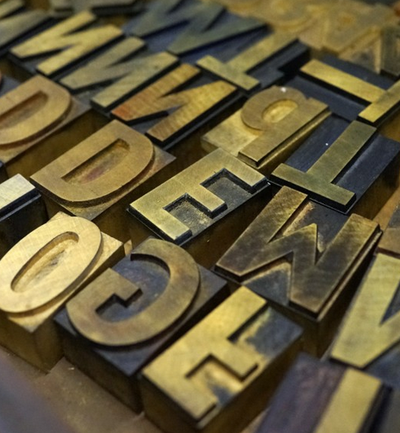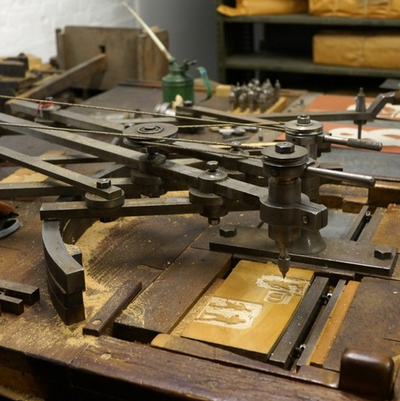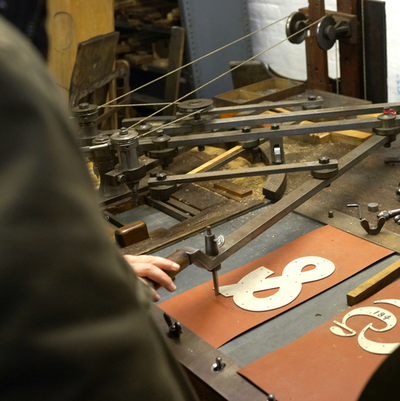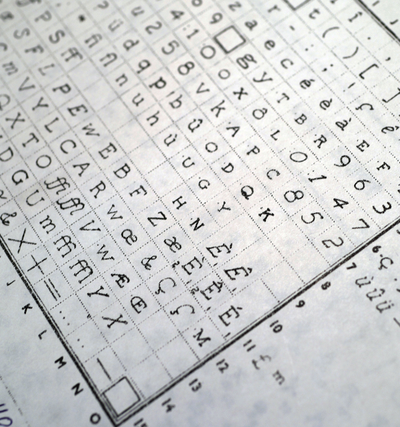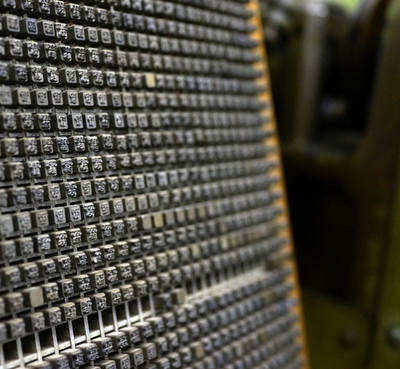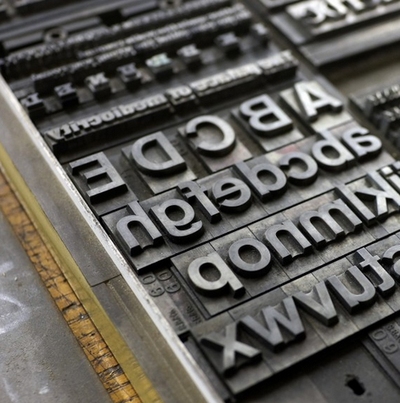An evening at the Type Archive
By CATHARINE MORRIS
How exactly were books – and the TLS, for that matter – printed before computers? Those curious to know the answer will find it at the Type Archive in Stockwell, London SW9. If they can get in, that is: the archive – the largest in Britain, containing three major typefounding collections (those of Stephenson Blake, the Monotype Corporation and Robert DeLittle) – moved into its attractive cobbled premises at 100 Hackford Road some twenty years ago, but it was only last week that it opened its doors to a crowd of visitors for the first time. We were there for two reasons: to celebrate the publication of the History of the Monotype Corporation by Judy Slinn, Sebastian Carter and Richard Southall; and to commemorate the 500th anniversary (mentioned here before) of the death of the great publisher Aldus Manutius.
The chairman of the Archive’s trustees, Nicolas Barker, took to what I think were library steps to address us on the subject of Aldus, whom he described as “the man who made the printed book what it is today”: “It all starts, as far as I’m concerned, in 1948, when I went to visit Will Carter [the founder of the Rampant Lions Press], with my first feeble attempts at typesetting. He took one shuddering look at them and said, ‘What you need is a decent font of sixteen-point Bembo’. I bought it and I have used no other. It’s everybody’s favourite type, the easiest thing to get anything right with".
It’s called Bembo, Barker told us, because it was based on a type cut in 1495 at Aldus’s behest and used for a text written by Pietro Bembo (an account of his expedition to Mount Etna); "and it has such perfection of form – it is the best and most universal of all Roman type letters – that it has been the basis of every one that’s followed”. Bembo's book was one of 150 Aldus published in his lifetime; among the others was a series of pocket books for which he commissioned a new kind of type: italic. “Nobody had seen an italic type before and everybody used to ask whose handwriting was it based on”, said Barker. “I can tell you – and I’ve said this in print and nobody has contradicted me yet – that it was based on the hand of Aldus Manutius himself.”
Next up the steps was the Archive’s founder, Sue Shaw, who said “we’ve never been daunted by anything here”. Just as well: from the History of the Monotype Corporation we learn that when the Archive was formed, the delivery of the materials took seven weeks, at a rate of two ten-ton lorries a day. Shaw told us a bit about the history of the buildings: at the end of the nineteenth century they were leased to the veterinary surgeons Prince & King, who came to specialize in the care of dogs and horses (there is still a hay room, complete with hay hooks). At times the buildings also housed small circus animals, including a baby zebra; and in 1912 they were home to two baby elephants, brought from India by the Daily Mirror as mascots for a charity – a footnote in the Archive’s history that explains its charming logo.
The Archive is not just an archive, in fact: it manufactures type matrices for letterpress printing (the moulds from which metal printing type is cast); and the trustees, who are not in their first youth, as Shaw put it, are taking measures to ensure that the skills involved are preserved for future generations. The Archive offers four-year apprenticeships, which have been taken up by Nick Gill and Ian Gabb with great success (Shaw described their achievements as “stupendously impressive”); and the trustees are now in a position, she said, to invite “volunteers and experts of all kinds to help on the web and in person”. She made clear that the Archive is not a museum; the hope is that guides can be trained and people shown selections of its 8 million artefacts by appointment in small groups.
There was plenty of time, before and after the speeches, wine and canapés, for us to inspect some of the artefacts ourselves. We could even observe some of the equipment being used: one of the youngest printers at the event told us – while printing beautiful type samplers – that she enjoys the constraints of traditional printing, and finds that they often result in simpler, more effective designs than digital methods would. (She also said that it’s surprisingly easy, and inadvisable, to press stray tools along with the paper.) Among my fellow wanderers, fortunately for us, was Richard Small; he took the photographs that accompany this post, and you will find many more on his blog.
A Commentary piece on Aldus Manutius, and a review of the History of the Monotype Corporation, will appear in future issues of the TLS.
Peter Stothard's Blog
- Peter Stothard's profile
- 30 followers


